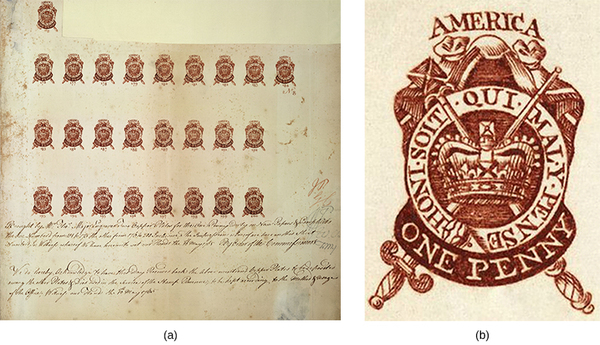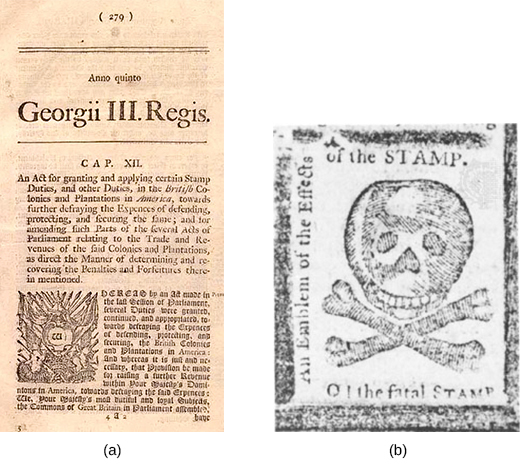| << Chapter < Page | Chapter >> Page > |
In 1765, the British Parliament moved beyond the efforts during the previous two years to better regulate westward expansion and trade by putting in place the Stamp Act. As a direct tax on the colonists, the Stamp Act imposed an internal tax on almost every type of printed paper colonists used, including newspapers, legal documents, and playing cards. While the architects of the Stamp Act saw the measure as a way to defray the costs of the British Empire, it nonetheless gave rise to the first major colonial protest against British imperial control as expressed in the famous slogan “no taxation without representation.” The Stamp Act reinforced the sense among some colonists that Parliament was not treating them as equals of their peers across the Atlantic.
Prime Minister Grenville, author of the Sugar Act of 1764, introduced the Stamp Act in the early spring of 1765. Under this act, anyone who used or purchased anything printed on paper had to buy a revenue stamp ( [link] ) for it. In the same year, 1765, Parliament also passed the Quartering Act, a law that attempted to solve the problems of stationing troops in North America. The Parliament understood the Stamp Act and the Quartering Act as an assertion of their power to control colonial policy.

The Stamp Act signaled a shift in British policy after the French and Indian War. Before the Stamp Act, the colonists had paid taxes to their colonial governments or indirectly through higher prices, not directly to the Crown’s appointed governors. This was a time-honored liberty of representative legislatures of the colonial governments. The passage of the Stamp Act meant that starting on November 1, 1765, the colonists would contribute £60,000 per year—17 percent of the total cost—to the upkeep of the ten thousand British soldiers in North America ( [link] ). Because the Stamp Act raised constitutional issues, it triggered the first serious protest against British imperial policy.

Parliament also asserted its prerogative in 1765 with the Quartering Act . The Quartering Act of 1765 addressed the problem of housing British soldiers stationed in the American colonies. It required that they be provided with barracks or places to stay in public houses, and that if extra housing were necessary, then troops could be stationed in barns and other uninhabited private buildings. In addition, the costs of the troops’ food and lodging fell to the colonists. Since the time of James II, who ruled from 1685 to 1688, many British subjects had mistrusted the presence of a standing army during peacetime, and having to pay for the soldiers’ lodging and food was especially burdensome. Widespread evasion and disregard for the law occurred in almost all the colonies, but the issue was especially contentious in New York, the headquarters of British forces. When fifteen hundred troops arrived in New York in 1766, the New York Assembly refused to follow the Quartering Act.

Notification Switch
Would you like to follow the 'U.s. history' conversation and receive update notifications?